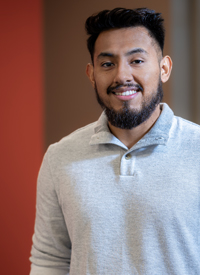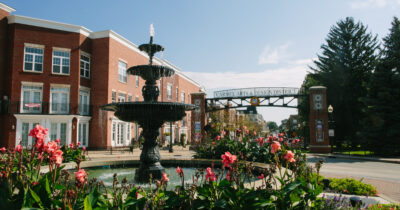-by Gabrielle Sanchez Steenberger
Communications Associate, CICF
In celebration of Hispanic Heritage Month, I sat down with Fabio Yataco, community leadership officer at The Indianapolis Foundation, who has been recognized several times as a leader in our philanthropic community. He recently joined the Líderes (leaders) fellowship,—a program created by Hispanics in Philanthropy—that celebrates and connects Latinx individuals working in philanthropy across the country.
NOTE: Individuals who fall under the historically used “Hispanic” term have varying experiences and may choose to identify with several different labels, including but not limited to; Latino, Latina, Hispanic, Latinx, Latine, or terms specific to the country of origin. For more comprehensive definitions of these terms, see the bottom of this post.

What is your role at The Indianapolis Foundation? How do you serve the organization and the community through this role?
I serve as a community leadership officer at The Indianapolis Foundation. My role at the foundation focuses on overseeing the workforce development and economic mobility portfolio. I also support a few of our leadership initiatives such as the BY Plus program and MORTAR. I have the privilege of serving the community in this role through not only a grantmaking perspective but by also being a thought partner on different initiatives and providing guidance to organizations applying for grants. One of the best parts of this role is building relationships with various community members and organizations in our city.
What is the Líderes Fellowship? What prompted you to apply?
The Líderes Fellowship is a program through Hispanics in Philanthropy that brings together a diverse group of mid-career professionals across the nation who serve in philanthropy and not-for-profit organizations. The program is centered around developing one’s leadership skills, executive presence, healing and vision for social justice. The fellowship promotes reflective practices through a racial equity lens and works toward the creation of an anti-racist philanthropic sector.
What prompted me to apply was not only my desire to further develop my learning but to also expand my network in the philanthropic sector. In addition to this, I wanted to meet and grow alongside members of my community who could relate to my lived experiences. Very grateful to my friend and colleague Juan Galeano for recommending the program.
What are some of your goals regarding transforming philanthropy? How does your identity as a Latino impact these goals?
Philanthropy by nature is uniquely positioned to help drive meaningful and transformative change. The issues that our BIPOC communities face every day is a result of systemic design. Therefore, my goal is to intentionally lean into trust-based philanthropy, continue building relationships with a variety of community members and listen to understand—to better be able to advocate, innovate and co-create.
I am very proud of my heritage and Latinidad. I would say my lived experiences and identity are essential to the way in which I approach my work. I believe the goals we have set for ourselves as a community foundation require a diverse set of perspectives and experiences in order to holistically approach our efforts.
“I am inspired by all the new faces I see who are getting involved, leading in their own way, and are working to make a positive impact in our community.”
What does true equity in philanthropy look like? What barriers still exist that we need to dismantle?
Equity in philanthropy for me is when we create robust and innovative ways to support organizations while providing the flexibility to learn from both successes and failures. As for barriers, there are deep structural inequities that are reinforced by legislation, policy, and practice that require systemic solutions. True equity can take form in philanthropy is when we immerse ourselves in trust-based philanthropy and integrate racial equity in all aspects of our work.
In this month of celebrating the beauty and diversity of Latinidad, what are you celebrating? What makes you proud and hopeful?
I am challenging myself to celebrate joy. There are honestly so many different things to celebrate about our community every day. Anything from our food, to our cultural celebrations, and our diversity within a community. We are a multilingual, multi-racial, and multi-generational community that is continuing to grow each day. I always smile when I see all of our flags in one room because I am reminded of the power that exists in our community and how different and unique every country is. Every country literally has their own Sazon (flavor). Being Peruvian, I have to say that Peru, of course, has the best!
One thing I am proud of is our community’s resilience and our ability to keep moving forward regardless of the policies, hate crimes or discriminatory practices. I am inspired by all the new faces I see who are getting involved, leading in their own way and are working to make a positive impact in our community. What makes me hopeful is that we as a community continue to grow in numbers. However, we remain under-represented across many sectors especially in positions of power. It is my hope that we begin to see a shift in this and that as a community we continue to rise together, build together, celebrate each other, and collectively work to empower those who will come after us.
Glossary of terms
There are many labels an individual may identify with. This is not a comprehensive list.
Afro-Latino
A term used by people of mixed cultural/racial heritage from both African and Latin descent.
Chicano/Chicana
A specific term popularized in the 1960s and 1970s refers to Mexican individuals living within the United States. This word also has political connotations, as it has been historically used in anti-assimilation movements, celebrating indigenous roots and rejecting colonial influence.
Hispanic
A term historically used to refer to those of Spanish descent. Some individuals consider this term to be outdated and inappropriate as it centers the identity of the Spanish colonizers over the indigeneity of people who inhabited a region for generations prior to European influence.
Latino
A term that refers to people from Latin, Central, or South America that are currently living in the United States. This term is not widely used outside of the United States.
Latina
The feminine version of the term “Latino”, referring to a group or individual.
Latinx/Latine/Latin@
Several versions of the term “Latino”, with an effort to remove the gendered aspect of the word. In Spanish, words fall into the feminine, masculine, or neutral category, and can usually be identified as such by the letter the word ends in. The letter “O” typically categorizes the word as masculine, “A” as feminine, and “E” as neutral. When referring to a group of people in Spanish, the identifier defaults to the masculine “Latino”. All three of these terms are gender-neutral. These terms can be used to describe a mixed-gender group, and can also refer to an individual or group of people who do not identify within the gender binary—such as the nonbinary and trans communities.
Latinidad
The cultural experience of being Latino, used to describe both collective and unique individual experience.
Mexican/Guatemalan/Chilean/Peruvian/Honduran/Salvadorian, etc.
Many individuals prefer to center the specific country from which they or their family come from instead of a larger region.






Leave A Comment